6-2 Strategies for Physical Environment
Now we’ll move on to specific strategies you can use to create a high-quality early learning environment.
Relevant Cultural Materials and Artifacts
Welcoming and supportive physical environments are structured and intentionally mindful of children’s cultures. Early learning artifacts reflect not just diversity, but also the actual culture of the children in the room.
Again, families are integral because they help build upon their home language and culture as their child learns new languages. Families can let educators know when cultural artifacts they place in their classrooms do not accurately reflect their culture.
Provide culturally diverse books in English and in children’s home languages. For books in different languages, ask parents to donate books from home. Diverse cultural community centers and organizations, such as religious groups or clubs, could also be good resources for books in a variety of languages.
In addition, educators can incorporate culturally-diverse toys. For instance, the first picture shows musical instruments and other artifacts from a Native American culture. The second picture shows a doll who uses a walker. The third picture shows a stuffed bear who uses a wheelchair.

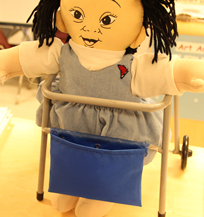
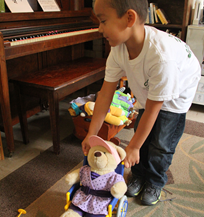
What examples can you share from your own early learning setting of relevant cultural materials and artifacts? Name the artifact and other characteristics such as where it comes from, who uses it, and when.
In the picture below, you can see how an educator who is part of the American Indian and Alaska Native Salish language immersion program set up her dramatic play area in a culturally relevant way. It has room for the educator and children to drum around a pretend fire.
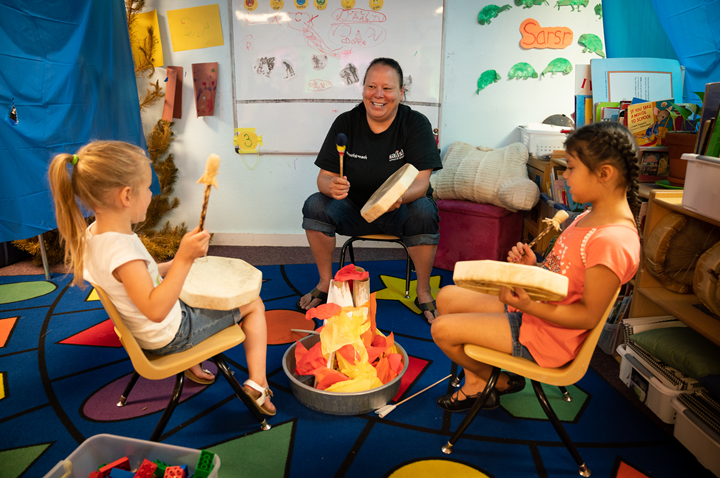
Why is it important to have these musical instruments available to play around the fire? Name similar or different examples from other cultures.
Educators also could use culturally diverse toys as tools for pretend play, such as costumes or play food items. The picture on the left shows articles of Native American clothing and accessories, which children can use during pretend play. The picture on the right shows sushi food items.
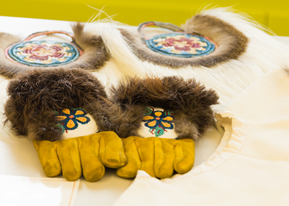

How could an educator incorporate culture into everyday materials they use in their learning setting? For instance, think about posters, art supplies, puppets, or math manipulatives.
In addition to relevant cultural materials and artifacts, a sense of belonging and acceptance is nurtured both through caring and responsive adult-child relationships and by identification with different cultural reference points. For example, children who are multilingual learners connect when they hear a peer or adult in the classroom speak their language(s). They gain a sense of belonging when they see a traditional activity from their culture discussed in a book or during circle time. A sense of belonging can boost children’s self-esteem and confidence and motivate them to learn.
Using visuals is a great way to create a supportive environment for children who are multilingual learners, and for all children in class. Pictures can help children remember and understand concepts better. Visuals with short descriptions in the classroom language help children describe and understand single words. For more complicated words and sentences, such as instructions, coupling pictures with print in the child’s primary language helps, too. Remember that supporting children’s home language also facilitates their English language acquisition.
Labels in English and in children’s home language can be made for high-frequency words or words more commonly used in the classroom. Instructions and classroom rules should also be provided in the children’s home language(s).
Printed labels should be:
- Clear and concise,
- At children’s eye level,
- In a large font, and
- Color-coded for each language.
Classroom Rules and Expectations
Young children who are multilingual learners benefit from having classroom rules and expectations explained to them in their home languages so they know how to interact and learn. When they clearly understand the rules and expectations, their environment is more predictable, and they feel safer and more comfortable.
When a language barrier impedes children’s understanding of the rules and behavioral expectations, they can grow anxious. If children feel excessive anxiety because they don’t understand the rules, they are more likely to shut down, withdraw, or act out.
These three images are an example of educators who made the classroom more predictable by making the rules explicit and accessible to children who are multilingual learners. They paired print with visuals and provided the information in children’s home language, in this case Spanish.
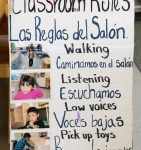
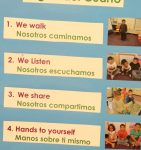
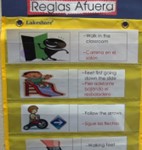
Here are other examples educators created for routines, such as nap time and mealtime. They paired visual pictures with written text.
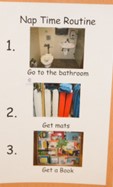
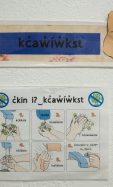
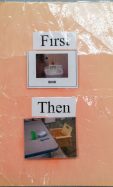
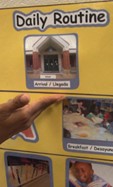
Educators can provide instructions and steps for the most common activities in their class, such as hand washing. Sometimes, these sets of instructions are already available online to download and post in the classroom.
Watch this brief video (0:26) showing activity instructions in an early learning environment. As you watch, consider how this is effective for all children, especially children who are multilingual learners.
Cultural Expectations
In addition to increasing predictability, here are some other questions to consider making the early learning environment as familiar, welcoming, and supportive as possible.
- Is it respectful for children to look adults in the eye?
- What kinds of food do children eat and who feeds them?
- What are the expectations about girls and boys playing together?
- How are babies swaddled?
At times, a family’s cultural expectations for their child’s early learning experiences may conflict with established program procedures or constraints. Can you think of a situation where this could happen? What would you do?
Part of feeling safe, wanted, and confident in a learning environment is to see one’s self reflected in that environment. That’s why it is important for children who are multilingual learners to see, hear, feel, and taste familiar aspects of their home life and language in their new learning environments.
As mentioned earlier, feeling safe also has to do with keeping the classroom consistent and predictable so children who are multilingual learners with lower English proficiency can anticipate what is coming and what is expected of them.
Not only should children see artifacts from their home cultures in the classroom, but also it is most important for each child to feel that their home culture and language is valued.
references
Castro, D. C., Espinosa, L. M., & Paez, M. M. (2011). Defining and measuring quality in early childhood practices that promote dual language learners’ development and learning. In M. Zaslow, I. Martinez-Beck, K. Tout, & T. Halle (Eds.), Quality measurement in early childhood settings (pp. 257-280). Brookes.
Goldenberg, C., Hicks, J., & Lit, I. (2013). Dual language learners: Effective instruction in early childhood. American Educator, 37(2), 26-29. [Journal article]
Magruder, E.S., W.W. Hayslip, L.M. Espinosa, & C. Matera (2013). Many languages, one teacher: Supporting language and literacy development for preschool dual language learners. Young Children, 68(1), 8-15. [Journal article]
Cite this source:
EarlyEdU Alliance (Publisher). (2020). 7-2 Strategies for Physical Environment. In Supporting Multilingual Learners Course Book. University of Washington. [UW Pressbooks]

